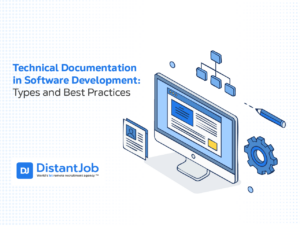Retaining top developers is about more than offering bigger paychecks. It requires creating a work environment that fosters both productivity and longevity. When your development team feels supported, challenged, and valued, they’re far less likely to look elsewhere for opportunities—and far more likely to stick around and help your business grow.
With tech companies losing from 13.2% to 18.3% of their top IT talent every year, it’s a red flag. And since you don’t want to be losing one out of every six or seven of your developers yearly, you need strategies in place that keep your developers productive, engaged, and committed for the long haul.
To help you with that I’ll share with you the top 5 strategies that will definitely lower your turnover rates and boost your developer retention.
Why Is Developer Retention Critical for Startups?
Replacing a single software engineer costs 30‑70 % of their annual salary and can delay active sprints by two or more weeks. Every resignation affects velocity, product knowledge, and team morale for cash-conscious startups, making proactive retention cheaper than repeated rehiring cycles.
For startups, retaining talent isn’t just an HR metric; it’s a survival metric. Why? Because:
- 13 %–18 % per year (U.S. average), that’s 1 of every 7 developers walking out annually.
- Hidden costs: recruitment fees, onboarding time, lost domain expertise, and productivity dips.
- High churn signals cultural or managerial issues, raising red flags during diligence rounds.
5 Proven Ways to Retain Your Top Software Developers
Let’s explore the 5 top strategies you can and should implement today if you want to make sure your top IT talent stays, from building a culture of connection to how async work is not really helping with longevity, what to do about interruptions and distractions, and how to empower your management team.
1. Why Do You Need to Build a Culture of Connection?
I often say that company culture means connection; the connection is the culture. So, if you want to build that culture of connections, start by fostering genuine personal interactions that help remote employee feel seen, heard, and valued.
So, instead of making every daily or weekly all about work. Rather, kick off your meetings by asking about your developers’ weekend, telling a quick story about something that happened to you or your family, or even wishing someone a happy birthday. Don’t make your team meetings about just routine check-ins; make it so they’re intentional moments to encourage genuine and real interaction. Also, try to share some of your hobbies on your team chat and encourage your team members to do the same, set up casual virtual hang-outs, or arrange one-on-one meetings. When you do this, you go from having a bunch of remote workers working somewhere individually to building a true team, a cohesive, connected unit, that gets along and works together well.
Another tip I always share is to be your team’s therapist. Which means paying attention and acting fast when you start noticing early signs of frustration or resentment—whether it’s passive-aggressive comments, subtle cues of dissatisfaction regarding salary or position, or even signs of depression and burnout. Besides their interpersonal relationships, their mental health should also be a top priority. Don’t let these signals pass you by; address them head-on and do so with empathy and open dialogue so they get resolved before they snowball and you end up losing your best coders. This way, you can build trust from the beginning by creating an environment where people feel free to share their feelings and work through disagreements constructively rather than letting them snowball into even bigger problems.
If you follow these tips and invest in legitimate interactions between you and your teams and amongst each of your team members, you’ll see that what you’re doing is actually laying the foundation for a culture where connection lowers your attrition rates and drives long-term developer retention.
2. Why Does Investing in Managers Pay Off?
Developers leave bad managers more often than low salaries. Empathetic, technically literate leaders cut churn by 25 %+.
So, it’s safe to say that strong management is, without a doubt, what holds any successful company together.
And what I’ve learned from my experience is that truly effective managers don’t just keep projects on track but also help create and put into action that connection culture we just talked about.They know their job isn’t to simply hand out tasks; it’s to work with their team and set a clear, consistent tone that everyone on their dev team can count on.
That’s why investing in your management team is key. And by investing I mean teaching them to notice subtle hints, like a shift in tone in a written message or a bit of uncertainty or anxiety during a call, and giving them the skills and tools they need in order to truly bond with their staff, tackle issues before they grow, and keep an eye on team spirit. When your leaders often check in, give clear direction, and make room for honest feedback, they build the kind of trust that keeps your IT talent loyal which, as a matter of fact, stops them from leaving. And let’s not forget: a great manager leads by example, by setting clear expectations, keeping their word, and encouraging open and honest talks.
And here’s the thing: when you invest in your leadership by giving them the right tools and knowledge and thus empowering them to become and be better leaders, you’re not just making your day-to-day operations better—you’re making sure your top software engineers work in an environment that’s conducive to their retention not their attrition.
3. Why You Shouldn’t Rely 100 % on Asynchronous Work
Pure async destroys human connection. It creates a sterile, cold work environment where real connections fade away or are never built to begin with. Blend async updates with scheduled real‑time touchpoints.
| Communication Mode | Best For | Cadence |
|---|---|---|
| Async tools (Slack, Notion) | Daily status, docs | Continuous |
| Live video (Zoom) | Design debates, conflict resolution | 1–2×/week |
| In‑person/off‑site | Team bonding, roadmap planning | Quarterly |
In remote work, where we all lack live interaction, it means you end up missing those important and subtle hints like your team’s tone, their expressions and their body language, that really help you understand how they’re actually doing. As a consequence, you risk turning your team’s interactions into robotic exchanges that don’t have the warmth and spontaneity of face-to-face conversations (and by face-to-face I don’t mean in-person, as you can have them remotely as well).
4. Minimize Interruptions
The two biggest enemies of productivity are interruption and distraction. And these two, in turn, are huge enemies of developer retention, since if they can’t get their work done, they’re more likely to feel demotivated and feel like taking other job offers.
In truth, when you interrupt someone in the middle of a task, you’re actually creating 22 minutes of damage on average. And that gets worse: studies have found that employees face disruptions every 11 minutes, and a striking 27% of these breaks actually result in delays lasting more than two hours before people can and do get back to their tasks.
That’s even more prominent in a traditional office setting, where you have a tap on the shoulder, someone invites you to a meeting you never knew about, you have to go for lunch, or you need to leave at 5 pm to go home.
Now, if you have a boss or a leader that’s very intuitive, they would only approach their employees when they’re hanging out, meaning they would pay attention to when they’re not doing their core work, and just by the water cooler or the cafeteria.
In a remote work environment, although you don’t have the disruptions I just mentioned (lunch, going home, etc) you also don’t have the water cooler or just the ability to actually see what your team members are doing at any given period of time, which makes minimizing interruptions much more challenging. But also extremely important.
So, as a leader yourself and also when you’re instructing your leaders, you should be aware of the real need to focus on not interrupting your employees. To do so:
- Establish clear boundaries and routines that prioritize focus while still keeping communication open, since as humans we need to connect, to have conversations.
- Schedule regular check-ins. This will prevent surprise interruptions, as all team members will know exactly when they can share updates, discuss problems, and get advice.
- Encourage your engineers to set their Slack to “away” when in the flow, so there are less chances of disruption.
- Prevent misunderstandings and lower the overall stress of trying to make sense of bits and pieces from endless texts. So, ultimately, a good balance between minimizing interruptions and allowing for real-time interaction is key to not only top delivery but also to top IT talent retention.
5. Schedule Regular Face-to-Face Meetings
By now, we’ve already talked about how important it is to connect with people and the problems that come from using async only, especially in a remote environment where it’s far too easy and common to end up buried in endless chat threads or messy email back-and-forths that don’t leave much room for real talk.
So, in order to nurture connections and really make sure that your company culture is well and thriving, schedule regular face-to-face meetings—both in small groups and one-on-one sessions—where you can truly interact with your team on a personal level.
And when we say “face-to-face” we mean use video, not just audio. Why? Because there’s a significant difference in terms of connections when you’re just listening to somebody speak rather than when you’re actually seeing someone’s face. In fact, 95% of professionals agree, stating that this type of meeting is key to long-term relationships.
In truth, face time has a huge impact on both establishing connections and keeping them alive, since you’re able to pick up on small signs—their expressions, body language, even the spark in their eyes—that show how they’re really feeling and doing. Which, as a result, doesn’t just bring the team closer, but also helps managers keep track of their workers’ mental health while balancing out the loneliness that often comes with working remotely.
The Bottom Line
Retention hinges on human connection, empathic leadership, balanced communication, protected focus time, and regular face‑to‑face contact. Combine these practices and make smart hiring decisions from the outset. And if you need help, you are in the right place. DistantJob’s specialty is to keep turnover low and innovation high.
Need vetted remote developers who’ll stay? Book a discovery call with our senior recruitment team.
Industry studies place the cost at 30–70 % of annual salary, factoring in hiring, onboarding, and lost productivity.
Aim for ≤10 % annually—anything higher signals cultural or managerial gaps





